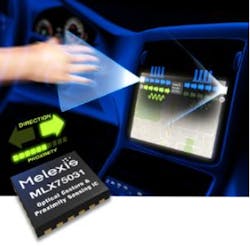Chips target automotive recognition systems
Design engineers developing automotive gesture recognition systems are faced with the challenge of building systems that can function in bright sunlight and work even in the presence of electro-magnetic interference.
To help them design such products, chip developer Melexis (Ieper, Belgium) has now launched the MLX75030 and MLX75031 optical gesture and proximity sensing ICs specifically for the task.
The devices feature two simultaneously operating light measurement channels which can detect the active optical reflection from a target. An ambient light suppression technique makes these channels tolerant to background light interference. Two additional channels are available to measure the ambient light in a vehicle.
On a system level, the MLX75030 and MLX75031 should be complemented by one or two LEDs and photodiodes, of any type, for detecting light. The MLX75030 allows external switches to drive the LEDs up to 1 A peak current, while the MLX75031 integrates the LED drivers to minimize external component count. Ambient light can be detected with up to two independent photodiodes.
The digital output from both devices represents the measured active light and ambient light levels, which can then be processed on a microcontroller to detect gestures such as swipe, zoom or scroll. A measurement rate of up to 700 Hz per measurement channel allows smooth interface response times.
Both devices are offered in a 4 mm x 4 mm, 24-pin surface mount QFN package. They have been AEC-Q100 qualified and will work in the - 40°C to 105°C temperature range.
Related items from Vision Systems Design that you might also find of interest.
1. Facial data makes cars safer
Engineers at the EPFL (Lausanne, Switzerland) are aiming to make cars of the future safer by developing a system that can capture the facial information of drivers.
2. Processors help designers develop smart cameras for cars
Freescale Semiconductor (Austin, TX, USA) is licensing intellectual property (IP) from CogniVue (Quebec, Canada) to build a new range of microprocessors aimed at helping designers build smart cameras for advanced driver assistance systems (ADAS).
3. Thermal camera prevents deer collisions
A researcher from the Northland Advanced Transportation Systems Research Laboratories at the University of Minnesota Duluth has developed a system to study whether infrared (IR) imaging systems can be used detect the presence of large animals such as deer and to track their locations using thermal imaging techniques.
-- Dave Wilson, Senior Editor, Vision Systems Design
